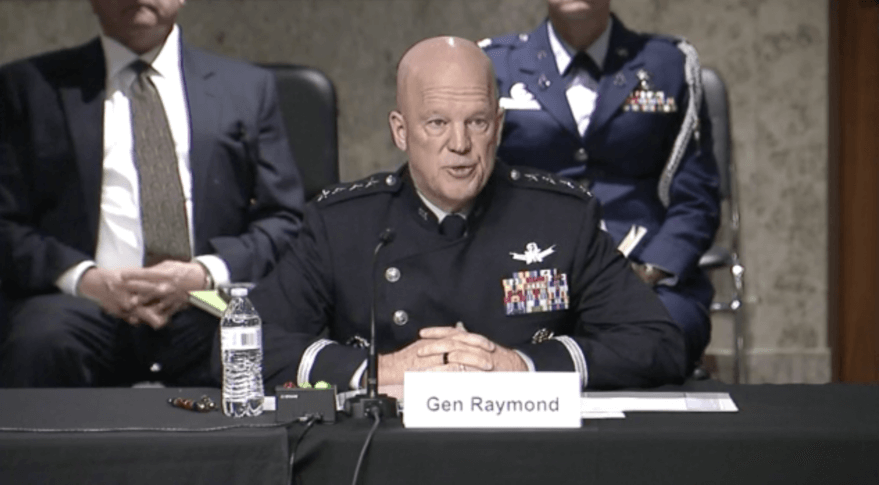
Space Force leaders questioned on their plans to invest in technology and workforce (Image Credit: Space News)

WASHINGTON – Members of the Senate Armed Services Committee pressed Air Force Secretary Frank Kendall and Chief of Space Operations Gen. John “Jay” Raymond on the Space Force’s plans to acquire next-generation technologies and develop the future workforce.
“Now that the Space Force is up and running, it is important to present a trained force with substantive capabilities to the combatant commands,” SASC Chairman Sen. Jack Reed (D-R.I.) said May 3 during a hearing on the Department of the Air Force’s 2023 budget request.
“It is critical for the Space Force to design its warfighting objectives in the same way the Chief of Naval Operations designs our Navy fleets and the Chief of the Air Force designs our air posture,” Reed said. “I will want to know your progress toward that objective.”
Raymond said the “number one mission” is to modernize the missile-warning space architecture to defend against increasingly advanced hypersonic missiles and glide vehicles being developed by U.S. adversaries.
He said the Space Force is investing in a mix of early-warning and tracking satellites in different orbits that will supplement existing systems.
“And it’s critical that we make this transformation,” he said. “We are diversifying the architecture to reduce the threat in space to an attack that may occur,” he added. “We pivot from handfuls of very exquisite, very expensive satellites, to an architecture that’s more diversified to get after both the emerging class of missiles and the threat that currently exists in space.”
A shift to “less exquisite with higher numbers allows us to adopt more of a business model that you might see commercial companies doing. And so that’s the transformation of our capabilities, that’s the path we’re headed down,” Raymond said.
Another priority is to keep track of objects orbiting in space and identify potential threats, said Raymond. “Space is becoming more congested, more contested and more competitive.”
Just a couple of years ago, U.S. Space Command was tracking about 22,000 objects, he said. “Today we’re probably tracking close to mid-40,000 objects.” Access to space is now easier and more affordable, “which provides us opportunities and challenges.”
Kendall said one of the challenges is deterring countries like Russia from conducting missile tests like the one in November that destroyed a satellite in orbit and left a huge cloud of debris.
“So we’ve got to get people to agree not to do that,” he said. Those destructive tests “put everything we have in space, in low Earth orbit, particularly at risk.”
He noted the recent decision by the United States to implement a self-imposed ban on anti-satellite missile tests . The next step will be to develop norms on how to conduct “proximity operations” such as when servicing vehicles approach satellites.
The National Space Council has been working on this, said Kendall, “to try to get wider appreciation of the need to allow us all to operate in space as a commons and to do so to the benefit of every nation.”
Preparing the future force
To help prepare its next generation of leaders, the Space Force is assigning new officers who graduate from the Air Force Academy to work at commercial companies and gain experience in the private sector, said Raymond.
Last year 118 graduates joined the Space Force. “We sent them to commercial companies and said, go figure out how they do that,” said Raymond. The Space Force wants to be agile and move fast, he said, “But I will tell you, it’s not like Amazon Prime where you can order it overnight. It’s going to take a little bit of time to build this, but that’s exactly where we’re headed.”
This year 101 cadets graduating from the Air Force Academy will be commissioned into the Space Force and also will get private-sector assignments.
Several senators asked whether the Space Force should have its own Space National Guard as a reserve component, an issue that is becoming more divisive. The White House in September said it opposed creating a separate Space National Guard due to concerns about cost and bureaucratic bloat. But some lawmakers continue to argue for the standup of a Space National Guard to ensure critical skills needed for space operations are not lost.
According to a proposal the Department of the Air Force submitted to Congress April 1, instead of having a dedicated reserve force, the Space Force would have a regular active-duty force with full-time and part-time members. The proposal does not recommend establishing a Space National Guard, which is in line with the Biden administration’s position.
Kendall said the Space Force needs the support now provided by more than 800 members of the Air National Guard in eight states. “We’re open to discuss” the way forward, he said, pointing out that the administration worries that “we would create a lot of overhead costs associated with a new organization.”
“I think we can find a way to keep those people doing what they’re doing. They’re very valuable. So we want to keep them around. They’re important to us,” Kendall said. “We just need to find the right mechanism to do it.”








